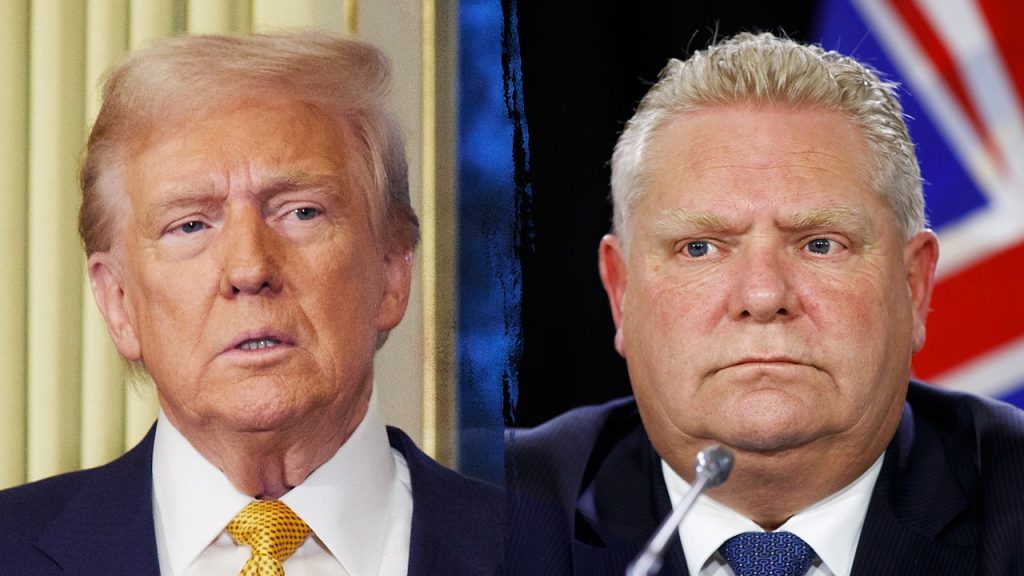The burgeoning trade tensions between the United States and Canada took a dramatic turn with then President-elect Donald Trump’s threat to impose a sweeping 25% tariff on all Canadian and Mexican imports. This protectionist measure, aimed at curbing illegal immigration and drug trafficking, sparked immediate backlash from Canadian officials, most notably Doug Ford, the premier of Ontario, a key oil-producing region. Ford’s retaliatory response involved a threat to disrupt the flow of vital resources, including energy and critical minerals, to the United States, specifically targeting neighboring states like Michigan, New York, and Wisconsin. This bold move underscored the potential for a significant trade war between the two traditionally close allies.
Ford’s threat to weaponize Ontario’s energy exports reflects the province’s significant role in North American energy markets. As one of the largest sources of U.S. energy imports, Ontario’s potential disruption could inflict considerable pain on American consumers and industries. This dependence on Canadian energy supplies provided Ford with considerable leverage in the escalating trade dispute, allowing him to signal that any U.S. tariffs would not go unanswered and would likely result in reciprocal measures impacting American businesses and citizens. Beyond energy, Ford also hinted at restricting exports of other essential commodities, including critical minerals and metals, further amplifying the potential economic fallout for the United States. He emphasized that other provincial leaders were also identifying key exports to leverage as potential retaliatory measures, suggesting a coordinated Canadian response to Trump’s protectionist policies.
Ford’s aggressive stance was not limited to energy and mineral exports. He also floated the idea of banning the sale of American-made alcohol within Ontario, a move aimed at impacting U.S. producers and further escalating the trade conflict. This multifaceted retaliatory strategy signaled a determination to protect Ontario’s economic interests and stand up to perceived unfair trade practices by the United States. However, the feasibility of Ford’s proposed actions remained uncertain, with legal and constitutional hurdles potentially limiting his ability to unilaterally implement such measures. Experts pointed out that decisions regarding inter-provincial and international trade often require federal government approval, raising questions about the extent of Ford’s autonomous authority in this matter.
Despite the legal ambiguities surrounding Ford’s proposals, his pronouncements ignited a firestorm of debate and speculation about the future of U.S.-Canadian trade relations. Trump responded to Ford’s threats with defiance, claiming that the United States was unfairly subsidizing Canada and that he was prepared to accept the consequences of a trade war. This rhetoric further fueled tensions and raised concerns about the potential for a protracted and damaging economic conflict between the two nations. Trump’s justification for the tariffs centered on the unsubstantiated claim that the U.S. was disproportionately burdened by its trade relationship with Canada, a narrative that disregarded the complex and mutually beneficial economic ties between the two countries.
In the midst of this escalating tension, Prime Minister Justin Trudeau engaged in direct diplomacy, meeting with Trump at Mar-a-Lago in an attempt to de-escalate the situation. Although the meeting was described as “productive,” the underlying trade dispute remained unresolved. This meeting highlighted the delicate balance Canada had to strike between defending its economic interests and maintaining a positive relationship with its powerful neighbor. The outcome of the Trudeau-Trump meeting underscored the complexity of the trade dispute and the need for a more nuanced approach than the tit-for-tat rhetoric that characterized the initial exchanges.
The confrontation between Doug Ford and Donald Trump epitomized the broader trade tensions simmering between the United States and Canada during this period. Ford’s retaliatory threats, while potentially constrained by legal and constitutional limitations, served as a powerful symbol of Canadian resistance to Trump’s protectionist agenda. The episode highlighted the deep economic interdependence between the two nations and the potential for significant disruption if a full-blown trade war were to erupt. It also underscored the complex political dynamics at play, with both domestic and international considerations shaping the responses of both Canadian and American leaders. The situation ultimately illustrated the precarious nature of international trade relations in an era of rising protectionist sentiment.















